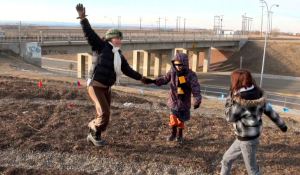The K-12 aim of the Saskatchewan arts education curricula is to enable students to understand and value arts expressions throughout life. This requires us to dance, to view and to share our thoughts about the art form.
Goals
Creative/Productive
We need to move, create, choreograph, invent, explore, rehearse, present. To do this we need to understand and apply the principles of composition and the elements of dance. We use the language of dance in order to create.
Critical/Responsive
To create dance with depth of understanding we need to also watch dances and discuss what we see, feel and think. We can analyze the way movement is organized, respond to the feeling or mood it inspires in the viewer, and interpret the dance through our own unique dance.
Cultural/Historical
As with all forms of the Arts, dance is represented by style, culture, geography and by eras. Students will be able to extend their own methods of creation and appreciation by extending their knowledge of the many forms and styles of dance through history.
Resources
1) Posters to print for the classroom
2) Props
Although not essential to a dance class, props can be useful for encouraging student engagement. Having a prop and a specific task is helpful to making the student feel safe and comfortable. All props can help to build students focus and sensitivity if used in the appropriate time and place.
The following three props are adapted from Anne Green Gilbert’s book ‘Brain Compatible Dance Education’.
Scarves – brightly colored fabric cut into squares or rectangles, used mainly for early grades (PreK – Grade 4). Props such as coloured scarves offer visual and tactile stimulation and help the student to stay focused on the task at hand.
Yoga Spots – yoga mats cut into circles (use a large bowl to trace the circle on the mat and cut out), and used mainly for early to middle years (PreK – Grade 7). Yoga spots help to define self and general space and aid teaching locomotor skills such as leaping and hopping.
Chopsticks – packages of chopsticks can be purchased cheaply at grocery or asian supply stores. Used mainly in middle to older years (Grade 5 – Grade 12), with students who are initially resistant to dancing. Chopsticks help students work cooperatively with a partner, exercising sensitivity while moving together.
Music
Educators often express frustration at finding the right music for a dance lesson.
Suggestions:
- Find a local musician to accompany dance classes. This allows the students to learn concepts of rhythm and musical composition while learning dance concepts. This has the added benefit of showing students how we value the work of artists.
- Eric Chappelle’s Music for Creative Dance CDs. This collection comes with movement suggestions for creating dance in the insert. All of Anne Green Gilbert’s books use Eric’s music in the outlines for dance exercises. The approach used is very compatible with the Saskatchewan Dance outcomes as well.
- Have students select music and discuss what kind of music interests them and how it could be incorporated into dance class.
- Look to local cultural music to find variations in time signature and style.
- Allow the role of the music in your class to vary. Don’t worry about always dancing ‘in time’ to the beat. Add variation to how the dancing responds to the music – dancing in time with the music, using the music as a background to the dancing, using movement to contrast the beat of the music.
- Dance in silence. This can be a powerful way to experience movement and allows one to focus on expression and inner thought.
- Dance to found sounds and improvised soundscapes from the environment. There are several music outcomes that suggest the importance of using the environment, found objects and voice to create a layered texture of “music”. Experiment with ways to combine music making and dance making.




